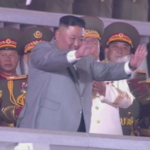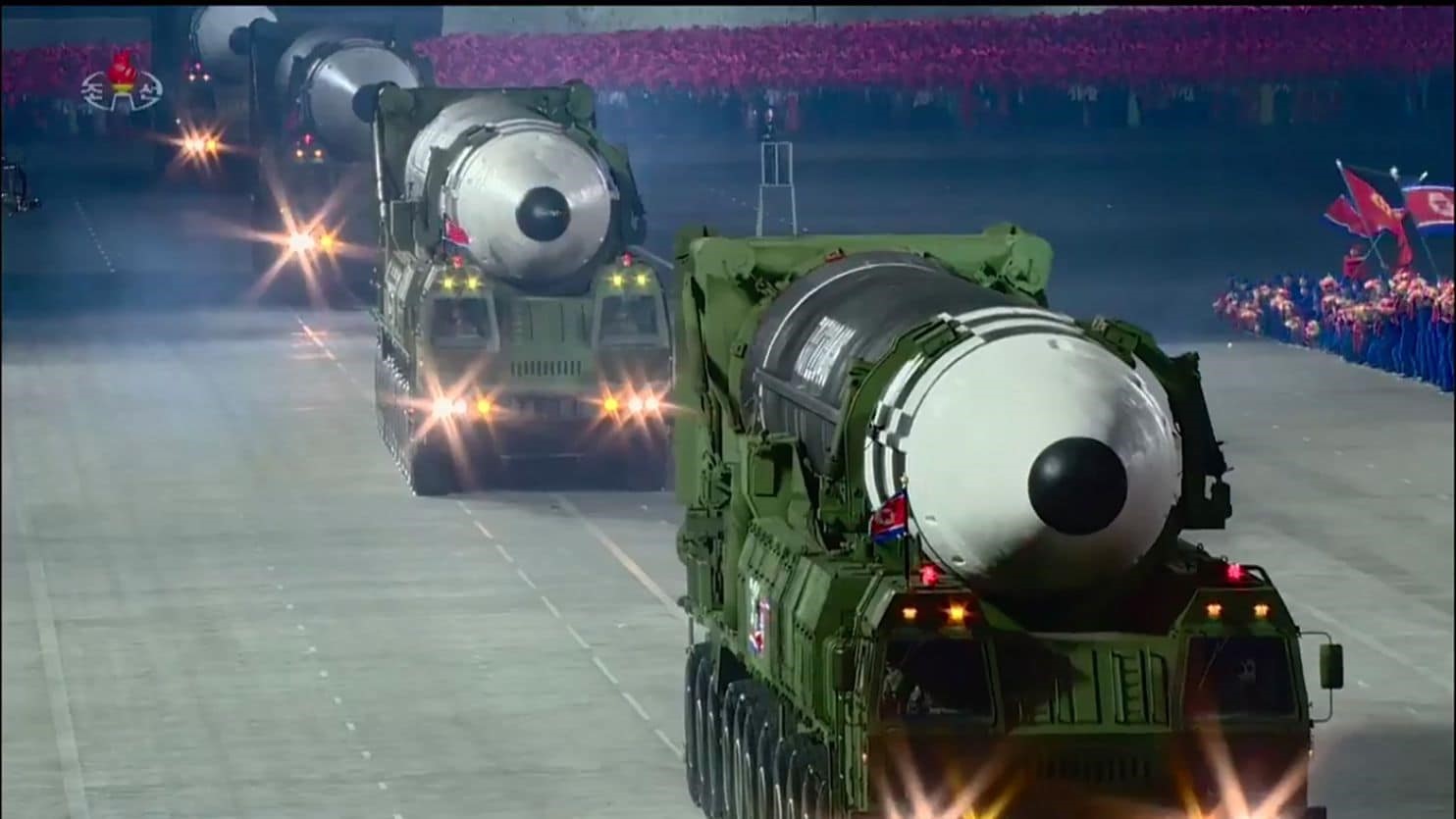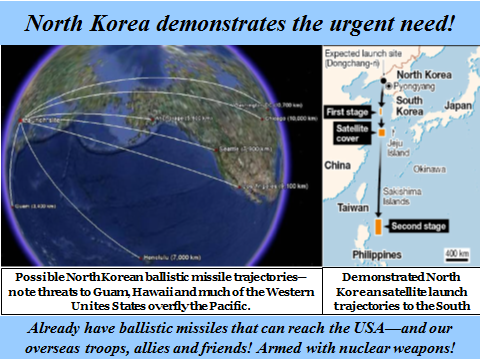North Korea continues to produce nuclear material and, between May 2019 and late March 2020, conducted multiple short-range ballistic missile tests in violation of United Nations Security Council prohibitions. And Kim Jong Un rolled out a new major intercontinental-range ballistic missile (ICBM) during an October 10, 2020 nighttime parade in Pyongyang.
Click here for an informative October 10, 2020 Washington Post article by Simon Denyer and Min Jon Kim titled “North Korea parades huge new ICBM, but Kim Jong Un stresses deterrent nature.” Kim reportedly also held out an “an olive branch” to its neighbor South Korea. They observed that Kim’s apparent message to the international community was “North Korea was a military force to be reckoned with, but not a threat.”
The military parade, which marked the 75th anniversary of the ruling Workers’ Party, included a vast array of modernized military systems, from small arms through antitank and air-defense systems — and notably a new liquid-fueled ICBM carried by a 11-axle vehicle — substantially larger than four of the older Hwasong-15 ICBMs tested in 2017, shown below.
An image taken from a North Korean state television broadcast on Oct. 10, 2020 shows North Korean Hwasong-15 intercontinental ballistic missiles during a military parade — AFP/Getty Images
North Korean state television said the new missile would be one of the largest road-mobile ICBMs in the world if it becomes operational and could represent the threatened new “strategic weapon” Kim had talked of at the start of this year. Click here for a December 31, 2019 Washington Post article by the same authors reporting on Kim’s promise of a “new strategic weapon” and new long-range missile tests.
Unusually, the military parade took place after midnight and was then shown on Korean Central Television on Saturday evening. Bright lights lit up the vast Kim il Sung Square, fireworks exploded in the sky and thousands of soldiers cheered and chanted in unison in a display of political and military theater.
Another intended message from the demonstration may have been posed in the context of our pending Presidential election. Click here for Deb Riechmann’s October 21, 2020 Military Times/AP article, titled “Growing North Korean nuclear threat awaits US election winner.” (Her article also shows a photo of the Hwasong-16 ICBM on its 11-axel launcher.)
She noted that former Vice President Joe Biden has attacked President Donald Trump about his friendly interactions with North Korea’s Supreme Leader Kim Jong Un, and the president noted that Biden and former President Barack Obama had not curtailed Kim’s nuclear ambitions. President Trump also noted, “We have a different kind of relationship. We have a very good relationship, and there’s no war.” (This comment no doubt reflected on then-President Obama’s message to President-elect Trump that North Korea was his greatest concern.)
Biden criticized this “chummy” relationship and said he would only consent to meet if Kim agreed to draw down his nuclear capacity — and would maintain pressure on China, which has leverage over the Kim regime. And Biden claimed Trump had permitted North Korea to have much more capable missiles, able to reach U.S. territory much more easily than ever before.”
But hasn’t Trump’s economic policies been doing what Biden proposes re. China? And did the Obama-Biden administration slow North Korea’s build up that produced the Hwasong-15 and Hwasong-16?
Click here for Jeff Gould’s October 20, 2020 Defense News elaboration of how “Trump, Biden trade[d] barbs over North Korea’s nukes” after Kim rolled out his new but still untested humongous ICBM. And click here for Michael Elleman’s October 21, 2020 38North article, “Does Size Matter? North Korea’s Newest ICBM” — which is very informative, at least about the design, testing and operations of the Hwasong-16 ICBM that is much larger than the Hwagong-15 ICBM tested in November 2017.
But both the report on Biden’s political banter and this technically oriented discussion ignore the reality that North Korea has been fielding nuclear threats to the American homeland for decades — as we have long discussed in our High Frontier messages since I began writing them. Click here for over ninety messages that deal with this longstanding threat from North Korea, beginning almost a decade ago on December 20, 2012.
Moreover, neither of these articles mentions the fact that North Korea has long placed in orbit satellites that could carry light-weight low-yield “super EMP” nuclear weapons to be detonated over the United States (or anywhere else) to yield civilization-ending havoc. Or that North Korea includes such capabilities in its military doctrine, and that Kim has explicitly highlighted the value of such an electromagnetic pulse (EMP) attack that would take down our electric power grid for an indefinite period.
Click here for my March 14, 2017 message during a time when the Washington intelligentsia was all a’twitter over the then latest series of North Korea’s tests. It recounted a bit of the history of dealing with North Korea since 1985 when it acceded to the Nuclear Nonproliferation Treaty — the terms of which it has never abided. I began that article, which I would recommend you consider again, by quoting Albert Einstein’s famous definition:
“Insanity: Doing the same thing over and over and expecting different results.” ~ Albert Einstein
That message emphasized the important role that cost-effective space-based ballistic missile defense (BMD) systems could play in countering this existential threat — and that such advantages had been ignored for decades; and recommended that President Trump revive the best concepts of President Reagan’s Strategic Defense Initiative (SDI) that were abandoned by the Clinton administration and ignored by subsequent administrations of both political parties.
Even though President Trump’s Space Force initiative is being initiated, so far there has been no sign of returning to the most important of the SDI concepts either, a fact also not missed at least by some others.
Click here for Brandon J. Weichert’s October 19, 2020 Washington Times article, “Only Star Wars can beat North Korea’s nukes,” followed immediately by Stanley Orman’s October 22, 2020 Letter to the Editor, “U.S. needs space-based defense” — found by clicking here — which adds the important fact that President Trump’s Space Force’s stated objectives do not include space-based defenses, which we recognized 30 years ago were the only way to achieve truly cost-effective BMD systems. Orman played a leading role in Great Britain’s related efforts during the SDI decade — 1983-93.
And I would add that over 30-years ago, in 1989, the SDI Brilliant Pebbles space-based BMD system became the first SDI concept to be approved by the top Defense Department Acquisition officials to enter a formal Demonstration and Validation Phase — and two competing contractor teams initiated efforts to prove a system of 1000 Brilliant Pebbles could be developed, deployed and operated for 20-years for $10 billion in 1988 dollars — which inflates to $20 billion today. And today’s technology is several times more advanced and the same size satellite constellation should be less expensive now.
That Brilliant Pebbles constellation system was expected to achieve an over 95-percent kill probability against an attack on the United States of 200 ballistic missile rentry vehicles (RVs), which had been “salvo launched” essentially together against widely separated targets, and could intercept such attacking elements in all phases of their flight from their boost-phase to and including their near simultaneous high-altitude reentry into the atmosphere over a wide array of targets.
Clearly, we could use such a capability today — but the Space Force, under Air Force leadership apparently can’t move beyond its longstanding efforts in building space sensors rather than pursuing actually employing the obvious advantages of space-based defenses — as has been understood to be the most effective defense concepts since Defense Advanced Research Projects Agency studies in the 1960s.
That era technology could not support then building such concepts, but SDI proved they were feasible 30 years ago; and the United States has ignored them since then Defense Secretary Les Aspin boasted in early 1993 that he “took the stars out of Star Wars.” Since then, both Democrat and Republican administrations have failed to exploit modern technology in providing that most cost-effective BMD system.
Meanwhile, the private sector is moving ahead in directly related development activities. For example, SpaceX just launched another 60 Starlink satellites, now in a constellation of nearly 900 low-altitude satellites, toward ultimately composing a constellation of up to 12,000 to provide a global internet capability.
So far, President Trump’s Space Force apparently continues to ignore employing such technology that traces its heritage to the SDI efforts of three decades ago to support building the most cost-effective space-based defenses — while China and others are actually employing SDI technology that has been ignored by the United States for three decades.
Now, let’s return briefly to addressing North Korea’s ballistic missile threat.
I agree with President Trump’s apparent approach of following Winston Churchill’s quip that “To jaw-jaw is always better than to war-war.” As one who spent ten years preparing for and engaging in negotiations with the Soviet Union, I understand that negotiations can lead to positive results that go far beyond what might first be considered to be possible. But we need negotiating leverage to succeed.
For example, few believed in the 1970s that the Soviets would ever agree to very intrusive inspection procedures; and so we spent many hours trying to figure out how to verify arms control agreements with “National Technical Means” (NTM) alone. I chaired a 1979 Air Force Scientific Advisory Board summer study panel to evaluate how NTM could be used to verify the MX system basing concepts then being considered to replace our Minuteman silo-based ICBMs. It was that background that led into the “arms control” portion of my professional career. And I then witnessed up-close and personal a major change in our approach to verifying arms control agreements — most notably especially by including essential intrusive inspection measures.
As I discussed last week (Click here.), beginning in the late 1960s we became increasingly concerned about the family of ballistic missiles that could deliver multiple warheads on U.S. — indeed global targets. In the late 1960s, we were concerned about the SS-9 which carried three warheads; and as expected it was replaced by a family of ICBMs — the SS-16, 17, 18 and 19 — that carried multiple warheads. The Soviet SS-20 intermediate-range nuclear force (INF) ballistic missile employed two of the three SS-16 ICBM stages.
Thanks to the policies of Ronald Reagan, extended into the George H.W. Bush administration, we reached historic verifiable agreements to get rid of the INF missiles that threatened NATO and those Mirved ICBMs. Mirved ICBMs carry multiple independently-targeted reentry vehicles, each with a nuclear warhead — and pose a significant threat to BMD systems such as we have deployed today.
Countering that threat was a major SDI objective — and Brilliant Pebbles cut the legs from under that Soviet approach and gave us negotiating leverage that led to the elimination of those highly Mirved ICBMs.
So is there any surprise that after the “powers that be” cancelled Brilliant Pebbles in 1993, the Russians again have been building Mirved ICBMs? And so will our other nuclear-armed adversaries, including China, North Korea and Iran.
It’s long past time for an SDI redo — and the new Space Force should wake up to that longstanding and ignored requirement and how it can support our negotiating efforts with Russia and China. And others. So, insisting on such worthy goals can lead to positive results, as President Ronald Reagan demonstrated . . . if we demand they be met, but those achievements can be lost if we do not persist with key supportive actions.
So . . . What to expect from future negotiations with North Korea — as a challenge for whoever wins the November 3rd election? And we must remember John Adam’s famous statement that “Facts are stubborn things.”
We can hope for the best, but “hope is not a strategy,” and negotiations will undoubtedly be very complicated given that progress will be impeded by a quarter century of failed attempts to block North Korea’s programs to produce a nuclear and ballistic missile capability — not just with Kim’s latest humongous ICBM. Kim long ago stated he has the nuclear weapons and the missiles he needed to deliver them — a claim I believe was and remains valid — a fact our negotiators must take it into account while we build our missile defenses in view of that reality.
The below chart, from one of my briefings several years ago, illustrates possible ballistic missile trajectories from North Korea on the left — and on the right the trajectory of North Korea’s launch of its space satellites toward the south. Note that many of these trajectories, then considered to be viable for North Korea, could be intercepted by our 44 or so ground-based interceptors in Alaska and California. But North Korea could overwhelm those defenses with a larger number of attacking ballistic missiles, which it may already have.
We also should take seriously North Korea’s explicit claim several years ago that achieving an EMP attack capability was a “strategic goal,” especially when considering the threat of nuclear weapons launched southward, whether from North Korea’s mobile ballistic missiles launchers — or from its satellite launch site illustrated above. And we should be supplementing our ballistic missile defense (BMD) systems to counter this threat.
We have had several opportunities for such supplements that deserved high priority. For example, click here and here for my 2017 and 2018 Newsmax articles arguing that we should quickly adapt U.S. aircraft to intercept ballistic missiles early shortly they are launched to counter this then existing threat. And click here for my April 20, 2018 Newsmax article noting that our negotiations with North Korea also could be quickly supported by enabling our (and Japan’s) Aegis BMD cruisers and destroyers near North Korea to provide such needed defenses. Whether the “powers that be” have improved our ability to counter the then perceived threats is unknown, at least to me. But I doubt it.
Just as the SDI gave enormous leverage to President Reagan’s negotiations with the Soviet Union, advancing our missile defense capabilities can advance our negotiations with Russia, China, North Korea and Iran. The President’s Space Force Initiative and related programs can be very helpful as well.
These conditions remind me of the second half of the 1980s, when I was privileged to lead the Defense and Space Talks with the Soviet Union and protected President Reagan’s SDI program against efforts to scuttle it.
Our opposition came from not only the Soviets but also from many in the international community as well as in the United States. Happily, we prevailed and can today provide at least limited defenses against missile attacks, though the Clinton administration cancelled the most important SDI products as discussed above.
But the SDI program that demonstrated the validity of President Reagan’s vision of building effective BMD systems, and his insistence that SDI was not negotiable, gave our overall negotiations considerable leverage. He walked out of the Reykjavik Summit in October 1986—34 years ago last week, because Gorbachev demanded that he restrict our space-based defense demonstrations to the laboratory.
This highly visible step made Reagan’s commitment clear, while he pocketed Soviet concessions in our negotiations on offensive nuclear forces—ultimately leading to historic arms control agreements.
In conjunction with his Strategic Modernization Program that repaired the impact of many years of neglect of our strategic systems, his thus demonstrated condition led to the first arms control treaties ever to reduce significantly the world’s nuclear weapons.
Bottom Lines.
Notably, Britain’s Prime Minister Margaret Thatcher claimed, “SDI ended the Cold War without firing a shot.”
We need a redo!
And remember that Winston Churchill was correct in stating “To jaw-jaw is always better than to war-war.” But successful negotiations to achieve agreements supporting U.S. national security interests must be backed up with persistent conditions.
Requiring a separate Space Force and related initiatives to build truly effective space-based defenses will be essential to a more stable future, no matter who is elected President
Stay tuned!
What Can You Do?
Join us in praying for our nation, and for a rebirth of the freedom sought, achieved and passed to us by those who came before us.
Help us to spread our message to the grass roots and to encourage all “powers that be” to provide for the common defense as they are sworn to do.
Begin by passing this message to your friends and suggest they visit our webpage www.highfrontier.org, for more information. Also, please encourage your sphere of influence to sign up for our weekly e-newsletter.
Encourage them to review our past email messages, posted on www.highfrontier.org, to learn about many details related to the existential man-made and natural EMP threats and how we can protect America against them. I hope you will help us with our urgently needed efforts, which I will be discussing in future messages.
Click here to make a tax deductible gift. If you prefer to mail a check, Please send it High Frontier, 20 F Street 7th Floor, Washington, DC 20001.
E-Mail Message 201020
Please click here to read Past Weekly Updates!
Please help High Frontier continue this important and timely work!
Be sure to follow us on our Social Sites!
If you found this letter via our Social Sites, and you would like to subscribe, please click below!








Sorry, comments are closed for this post.